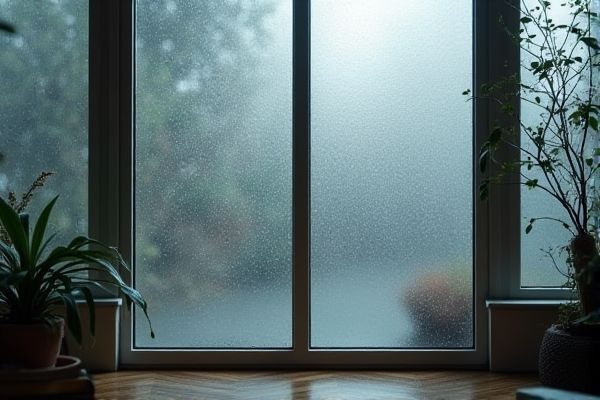
Rain glass features a textured surface with vertical streaks that mimic the look of falling rain, providing privacy while allowing natural light to filter through, whereas frosted glass has a uniformly etched or sandblasted finish that offers a soft, blurred effect for enhanced privacy and diffused light. Explore the rest of the article to understand which glass type best suits your design needs and personal preferences.
Table of Comparison
| Feature | Rain Glass | Frosted Glass |
|---|---|---|
| Appearance | Textured surface with a pattern resembling raindrops | Opaque, matte finish that diffuses light evenly |
| Privacy | Moderate privacy; distorts vision but some shapes visible | High privacy; blocks clear view completely |
| Light Transmission | Allows light with minimal distortion | Diffuses light, softening brightness |
| Common Uses | Shower enclosures, decorative windows, doors | Bathrooms, office partitions, windows requiring privacy |
| Maintenance | Needs regular cleaning to avoid dirt in textured grooves | Easy to clean, smooth surface resists fingerprints |
| Cost | Generally moderate-cost due to decorative texture | Varies; typically affordable due to simple manufacturing |
Introduction to Rain Glass and Frosted Glass
Rain glass features a textured surface with water droplet patterns that distort light while maintaining partial transparency, commonly used for decorative windows and privacy without sacrificing brightness. Frosted glass undergoes a sandblasting or acid-etching process to produce a uniform, matte finish that diffuses light evenly and offers enhanced privacy by blocking direct visibility. You can choose between rain glass and frosted glass based on your preference for aesthetic texture versus consistent opacity in interior or exterior applications.
Key Differences Between Rain Glass and Frosted Glass
Rain glass features a textured surface with water droplet patterns that create a decorative, translucent effect, while frosted glass has an evenly sandblasted or acid-etched finish that provides uniform opacity and privacy. Rain glass is often used in decorative windows, doors, and sidelights to add visual interest without completely obscuring light, whereas frosted glass is favored for bathrooms, office partitions, and shower enclosures where privacy is a priority. The main difference lies in texture and translucency: rain glass offers varied patterns with partial visibility, whereas frosted glass offers consistent diffusion of light with minimal visibility.
Aesthetic Appeal: Comparing Visual Styles
Rain glass features textured patterns that mimic raindrops, creating a dynamic visual effect that adds depth and interest to windows, while frosted glass offers a smooth, matte finish that provides a sleek, modern look with privacy. Your choice between rain glass and frosted glass impacts the window's aesthetic appeal depending on whether you prefer the natural, decorative texture of rain glass or the subtle, uniform elegance of frosted glass. Both options enhance interior or exterior designs but cater to different visual styles and functional preferences.
Privacy Levels: Which Glass Offers More?
Rain glass provides moderate privacy by distorting views with its textured, water-like pattern, making it ideal for spaces where partial obscurity is sufficient. Frosted glass offers a higher level of privacy by creating a uniformly opaque surface that blocks detailed visibility completely. For environments requiring maximum confidentiality, frosted glass is the preferred choice over rain glass.
Light Diffusion and Brightness
Rain glass features a textured surface with water droplet patterns that scatter light, creating a dynamic play of shadows and highlights while maintaining brightness. Frosted glass uses acid etching or sandblasting to produce a uniformly matte finish, diffusing light softly for a consistent, gentle illumination without glare. Both types enhance privacy, but rain glass allows more variation in light diffusion, whereas frosted glass offers evenly distributed brightness.
Common Applications in Interior Design
Rain glass is commonly used in interior design for shower doors, partitions, and windows where a textured, water-inspired aesthetic enhances privacy without compromising natural light. Frosted glass is favored for bathroom windows, office partitions, and cabinet doors, providing a smooth, opaque surface that diffuses light while ensuring complete privacy. Both materials serve functional and decorative purposes, with rain glass adding a tactile visual interest and frosted glass offering a sleek, modern finish.
Maintenance and Cleaning Requirements
Rain glass requires gentle cleaning with mild soap and water to maintain its textured surface without damaging the unique patterns that diffuse light. Frosted glass, often coated with acid or sandblasted, needs careful cleaning to avoid scratching or wearing down its smooth, matte finish; non-abrasive cloths and glass cleaners work best. Your choice affects maintenance time, with rain glass being slightly more forgiving of regular gentle cleaning compared to frosted glass's need for careful handling to preserve its appearance.
Durability and Longevity
Rain glass features a textured surface that effectively conceals water spots and smudges, contributing to its durability in outdoor or humid environments. Frosted glass is created through acid etching or sandblasting, resulting in a smooth, matte finish that can be more susceptible to scratches but offers excellent resistance to shattering. Your choice depends on whether you prioritize a decorative, durable surface with weather resistance or a sleek, elegant finish with moderate durability.
Cost Comparison: Rain Glass vs Frosted Glass
Rain glass typically costs 20-30% more than frosted glass due to its textured surface and complex manufacturing process. Frosted glass is more affordable and widely used in residential and commercial settings because it offers privacy at a lower price point. Budget-conscious projects often favor frosted glass, while rain glass is chosen for its decorative appeal despite the higher cost.
Choosing the Right Glass for Your Project
Rain glass features textured patterns that enhance privacy and add a decorative element, while frosted glass provides a smooth, translucent surface for maximum light diffusion and subtle obscuration. Consider rain glass if you desire a unique visual texture and artistic flair, ideal for shower doors or cabinet inserts; choose frosted glass for a sleek, modern look that ensures privacy without sacrificing natural light, perfect for office partitions or bathroom windows. Your project's aesthetic goals, privacy needs, and light requirements will guide the best glass selection for a functional and stylish outcome.
 homyna.com
homyna.com